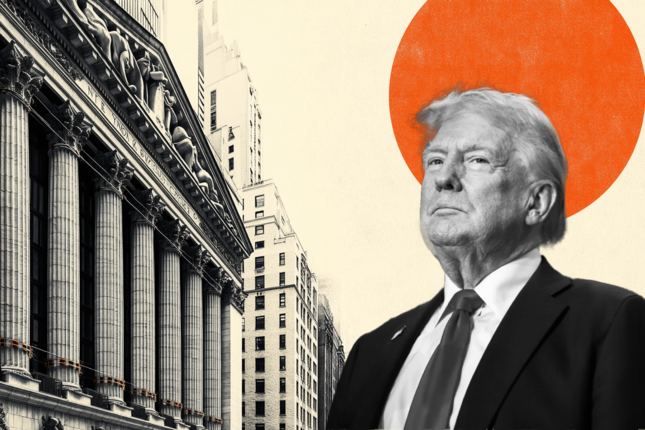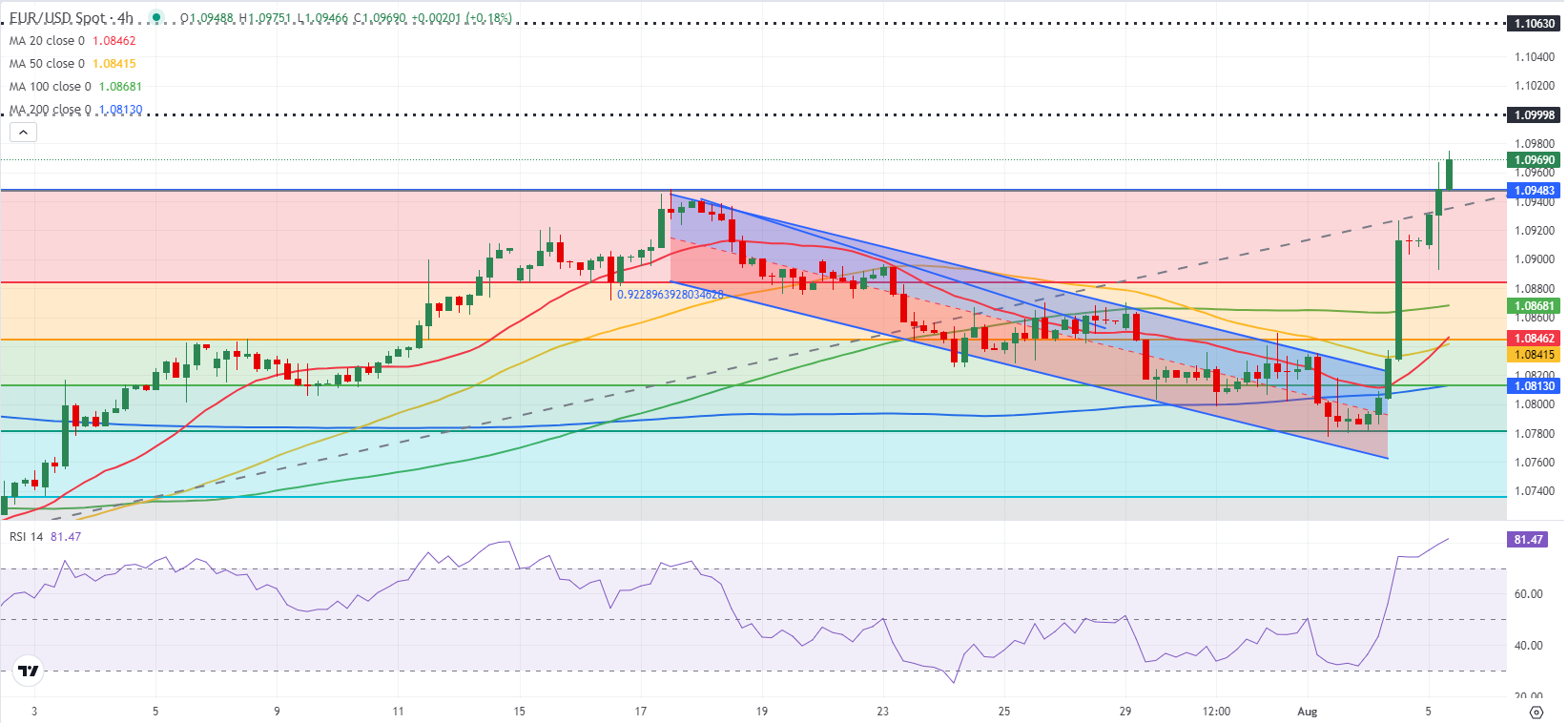- EUR/USD trades at its highest level since March above 1.0900 on Monday.
- The US Dollar stays under heavy selling pressure at the start of the week.
- The risk-averse market atmosphere could limit the pair's upside.
After gaining more than 1% on Monday, EUR/USD extended its rally early Monday and reached its highest level since March near 1.0970. The pair's near-term technical outlook points to overbought conditions.
Euro PRICE Last 7 days
The table below shows the percentage change of Euro (EUR) against listed major currencies last 7 days. Euro was the strongest against the Australian Dollar.
| USD | EUR | GBP | JPY | CAD | AUD | NZD | CHF | |
|---|---|---|---|---|---|---|---|---|
| USD | -1.01% | 0.54% | -7.07% | 0.26% | 1.43% | -0.58% | -3.76% | |
| EUR | 1.01% | 1.53% | -6.14% | 1.30% | 2.51% | 0.41% | -2.75% | |
| GBP | -0.54% | -1.53% | -7.59% | -0.24% | 0.98% | -1.08% | -4.22% | |
| JPY | 7.07% | 6.14% | 7.59% | 7.85% | 9.16% | 6.97% | 3.59% | |
| CAD | -0.26% | -1.30% | 0.24% | -7.85% | 1.20% | -0.87% | -3.98% | |
| AUD | -1.43% | -2.51% | -0.98% | -9.16% | -1.20% | -2.01% | -5.22% | |
| NZD | 0.58% | -0.41% | 1.08% | -6.97% | 0.87% | 2.01% | -3.17% | |
| CHF | 3.76% | 2.75% | 4.22% | -3.59% | 3.98% | 5.22% | 3.17% |
The heat map shows percentage changes of major currencies against each other. The base currency is picked from the left column, while the quote currency is picked from the top row. For example, if you pick the Euro from the left column and move along the horizontal line to the US Dollar, the percentage change displayed in the box will represent EUR (base)/USD (quote).
Disappointing labor market data from the US triggered an intense US Dollar (USD) selloff in the American session on Friday. Nonfarm Payrolls in the US rose 114,000 in July, missing the market expectation of 175,000 by a wide margin, and the Unemployment Rate climbed to 4.3% from 4.1% in June. Following the July jobs report, the CME FedWatch Tool shows that markets are nearly fully pricing in a 50 basis points Federal Reserve (Fed) rate cut in September.
Meanwhile, reports of Iran preparing to attack Israel in the next 24–48 hours force investors to seek refuge at the beginning of the week. Growing fears over a deepening conflict in the Middle East cause risk-sensitive assets to stay under selling pressure during the European trading hours. At the time of press, Euro Stoxx 50 was down 2.5% on the day and US stock index futures were losing between 1.5% and 3.8%.
In the American session, the ISM will release the Services PMI report for July. Investors expect the headline PMI to rise to 51 from 48.8. in June. A better-than-forecast print could ease concerns over an economic downturn in the US and help the USD stage a rebound with the immediate reaction.
Investors will keep a close eye on geopolitics in the second half of the day. Unless tensions in the Middle East ease, the market volatility could remain high in the near term.
EUR/USD Technical Analysis
The Relative Strength Index (RSI) indicator on the 4-hour chart rose above 80, reflecting overbought conditions for the pair. On the upside, 1.1000 (psychological level, static level) aligns as next resistance before 1.1060 (static level from May 2023) and 1.1100 (psychological level, static level).
1.0950 (static level, former resistance) could be seen as first support. If EUR/USD drops below that level and starts using it as resistance, it could extend its downward correction toward 1.0900 (psychological level, static level) and 1.0870 (100-period Simple Moving Average).
Euro FAQs
The Euro is the currency for the 20 European Union countries that belong to the Eurozone. It is the second most heavily traded currency in the world behind the US Dollar. In 2022, it accounted for 31% of all foreign exchange transactions, with an average daily turnover of over $2.2 trillion a day. EUR/USD is the most heavily traded currency pair in the world, accounting for an estimated 30% off all transactions, followed by EUR/JPY (4%), EUR/GBP (3%) and EUR/AUD (2%).
The European Central Bank (ECB) in Frankfurt, Germany, is the reserve bank for the Eurozone. The ECB sets interest rates and manages monetary policy. The ECB’s primary mandate is to maintain price stability, which means either controlling inflation or stimulating growth. Its primary tool is the raising or lowering of interest rates. Relatively high interest rates – or the expectation of higher rates – will usually benefit the Euro and vice versa. The ECB Governing Council makes monetary policy decisions at meetings held eight times a year. Decisions are made by heads of the Eurozone national banks and six permanent members, including the President of the ECB, Christine Lagarde.
Eurozone inflation data, measured by the Harmonized Index of Consumer Prices (HICP), is an important econometric for the Euro. If inflation rises more than expected, especially if above the ECB’s 2% target, it obliges the ECB to raise interest rates to bring it back under control. Relatively high interest rates compared to its counterparts will usually benefit the Euro, as it makes the region more attractive as a place for global investors to park their money.
Data releases gauge the health of the economy and can impact on the Euro. Indicators such as GDP, Manufacturing and Services PMIs, employment, and consumer sentiment surveys can all influence the direction of the single currency. A strong economy is good for the Euro. Not only does it attract more foreign investment but it may encourage the ECB to put up interest rates, which will directly strengthen the Euro. Otherwise, if economic data is weak, the Euro is likely to fall. Economic data for the four largest economies in the euro area (Germany, France, Italy and Spain) are especially significant, as they account for 75% of the Eurozone’s economy.
Another significant data release for the Euro is the Trade Balance. This indicator measures the difference between what a country earns from its exports and what it spends on imports over a given period. If a country produces highly sought after exports then its currency will gain in value purely from the extra demand created from foreign buyers seeking to purchase these goods. Therefore, a positive net Trade Balance strengthens a currency and vice versa for a negative balance.
Information on these pages contains forward-looking statements that involve risks and uncertainties. Markets and instruments profiled on this page are for informational purposes only and should not in any way come across as a recommendation to buy or sell in these assets. You should do your own thorough research before making any investment decisions. FXStreet does not in any way guarantee that this information is free from mistakes, errors, or material misstatements. It also does not guarantee that this information is of a timely nature. Investing in Open Markets involves a great deal of risk, including the loss of all or a portion of your investment, as well as emotional distress. All risks, losses and costs associated with investing, including total loss of principal, are your responsibility. The views and opinions expressed in this article are those of the authors and do not necessarily reflect the official policy or position of FXStreet nor its advertisers. The author will not be held responsible for information that is found at the end of links posted on this page.
If not otherwise explicitly mentioned in the body of the article, at the time of writing, the author has no position in any stock mentioned in this article and no business relationship with any company mentioned. The author has not received compensation for writing this article, other than from FXStreet.
FXStreet and the author do not provide personalized recommendations. The author makes no representations as to the accuracy, completeness, or suitability of this information. FXStreet and the author will not be liable for any errors, omissions or any losses, injuries or damages arising from this information and its display or use. Errors and omissions excepted.
The author and FXStreet are not registered investment advisors and nothing in this article is intended to be investment advice.
Recommended Content
Editors’ Picks

EUR/USD recovers toward 1.0400 as USD rally loses steam
EUR/USD recovers from daily lows toward 1.0400 in the American session on Tuesday. Following the earlier rally, the USD struggles to preserve its strength as the bullish opening in Wall Street's main indexes point to an improving risk mood.

GBP/USD stays below 1.2300 after UK employment data
GBP/USD rebounds from session lows but remains below 1.2300 in the second half of the day on Tuesday. The US Dollar clings to modest gains but finds it difficult to gather further bullish momentum as the impact of Trump's tariff threats fade.

Gold climbs to fresh multi-month high above $2,730
Gold gathers bullish momentum and trades at its highest level since early November above $2,730 on Tuesday. The benchmark 10-year US Treasury bond yield is down more than 1% below 4.6% following US President Trump's tariff threats, helping XAU/USD push higher.

Bitcoin fails to sustain the $109K mark after Trump’s inauguration
Bitcoin’s price steadies above the $102,000 mark on Tuesday after reaching a new all-time high of $109,588 the previous day. Santiment’s data shows that BTC prices quickly corrected, as social media showed major greed and FOMO among the traders in Bitcoin after President Donald Trump’s inauguration.

Prepare for huge US trade changes as Trump goes America first
You can be sure that big changes are coming as far as US trade is concerned, even if we didn't get any new tariffs on President Trump's first day in office. A comprehensive investigation into US trade relationships was initiated via a memorandum. China, Canada, and Mexico are clearly in the immediate firing line.

Trusted Broker Reviews for Smarter Trading
VERIFIED Discover in-depth reviews of reliable brokers. Compare features like spreads, leverage, and platforms. Find the perfect fit for your trading style, from CFDs to Forex pairs like EUR/USD and Gold.
